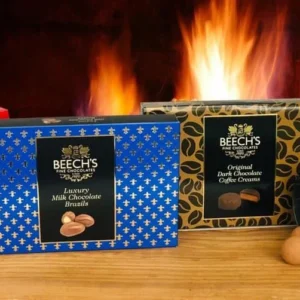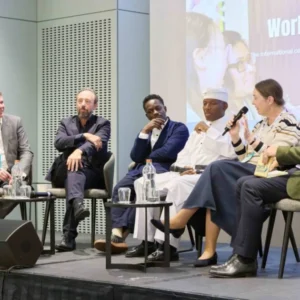What price chocolate?

Susannah Millen reports on the Academy of Chocolate Conference, which was held at The Royal Automobile Club in London’s Pall Mall in October.
I was very much looking forward to attending the third Academy of Chocolate Conference, and the event was just as fascinating and inspirational as I had hoped.
With rising interest in quality chocolate brands in the UK as well as in other international markets, the event, which is held bi-annually to coincide with the presentation of the Academy of Chocolate Awards, was particularly well attended by many of the increasingly familiar figures in the sector.
The day kicked off with an introduction from Sara Jayne Stanes OBE, chairman of the Academy of Chocolate and CP board member, and was ably hosted for the rest of the day by broadcaster and journalist Simon Parkes.
Cocoa cultivation
First up was a discussion on cocoa cultivation and genetics during which international cocoa consultant Robin Dand described chocolate as being ‘like wine’. The genetics of a cocoa tree are the biggest factor in terms of influencing bean flavour, he explained. He also discussed how the price of cocoa has fallen in real terms due to inflation.
Frank Homann from Xoco, a cocoa grower in Madagascar and Brazil, described how one cocoa pod can contain beans with various different genetics, which can only be identified once the pods are open. And Craig Sams, a strong advocate of fair trade, organic farming and the founder of Green & Black’s warned that in the future cadmium and lead levels in the soil of cocoa plantations will need to be measured. He concluded by saying: “The balance of power is shifting to the farmer.”
Child labour
During the next discussion, which examined issues relating to child labour, international cocoa and chocolate consultant Tony Lass put the hardships faced by farmers and the issue itself into perspective by explaining how cocoa farming families continue to live in poverty due to poor revenue and that small holders therefore cannot afford to pay day labourers. Sometimes it is even farming practices themselves that mean that children have to carry out certain tasks. For example, when cocoa trees are well maintained and pruned the branches low down on the trunk are cultivated, but those that are grown in a less controlled environment require children to climb the trunk in order to retrieve the cocoa pods from the top of the trees.
As an alternative scenario, he said, a move towards using large scale plantations hasn’t worked because cocoa is hard to farm on a large scale as it is a difficult crop to mechanise. There is also the issue that the workforce is not needed consistently due to the fact that there is a cocoa harvest only twice per year, and workers would only be needed on a more regular basis if there was a guaranteed market for the crop.
Luned Tonderai showed excerpts of an award winning episode of BBC Panorama she co-produced, which saw reporter Paul Kenyon go undercover as a cocoa trader to expose the use of child trafficking and child labour in the cocoa fields of West Africa.
Although the situation has improved in some cocoa producing areas since the making of the documentary, such practices are endemic to the culture and changes are likely to happen very slowly. Borjana Pervan, head of communications at the International Cocoa Initiative, revealed how the organisation aims to improve the lives of children and help to eliminate child labour. She spoke of how 98 per cent of children engaged in child labour are working on family farms in Ghana and the Ivory Coast. Making a change, she explained will depend on collective action and shared responsibility.
A brief discussion then followed on the potential benefits of processing in the country of origin. Tony Lass explained that one of the problems is that milk and sugar supplies are limited in cocoa producing countries. A controlled temperature environment is also necessary and obviously this is a particular problem in underdeveloped countries with hotter climates. However, although the major cocoa processing companies do some processing in the producing countries, this does not increase revenue for the farmer. He ascerted that farmers need to be rewarded better in order for them to choose to be cocoa growers. On the subject of some of the programmes that have been put in place to improve the lives of cocoa farmers by large industry players, Frank Homann suggested that instead of paying for schools and so on, they should simply pay farmers more for the crop.
Bean to bar
After a coffee break, the discussion turned to bean to bar – myth versus fact. With a growing number of chocolate manufacturers labelling their products ‘bean to bar,’ there is some debate as to what this actually means. For example, some brands manage the entire process from sourcing the cocoa beans in order to manage the quality to manufacturing chocolate bars, while others buy in their beans the origins of which may be difficult to ascertain.
Peter Emmerson from Barry Callebaut described how its beans are cleaned before roasting and that a ‘kill step’ has been introduced into processing during which the beans are heated to 120 degrees to remove traces of Salmonella and other contaminants. In response to demand, the company now uses sunflower as well as soya lecithin and is also starting to use rapeseed.
Chris Brennan’s business, Pump Street Bakery, focuses on quality and processing raw materials. His view that chocolate is a luxury and not a commodity underpins his method of selecting beans carefully from individual farmers and producing small batches. He also matures his chocolate bars for 30 to 35 days.
Ricardo Illy, whose family is best known for its coffee empire, spoke about how his grandfather originally produced coffee and chocolate, but stopped making chocolate due to the greater complexity of the production process. The family now owns Italian brand Domori, which does not use lecithin in its chocolate production and uses cane sugar that is of the same origin as its Venezualan cocoa beans.
Richard Turner from Mood Foods then described how he produces his healthier ‘raw’ chocolate product. The beans are dried rather than roasted, and the temperature is kept low during processing to retain the health benefits found in natural cocoa. This led to a debate about what temperature food can actually be exposed to while still being described as raw. For example, is additional heat generated during grinding? However, he explained that the beans are not ground and described how they are cleaned and washed using organic detergent to avoid health and safely issues.
Sustainability
With transparency becoming an increasingly important issue for consumers, we were challenged to consider where our high street chocolate products come from. “An industry is no more sustainable than its supply chain,” said Pierre Courtemanche, founder of GeoTraceability, a company that specialises in data collection on smallholders and the traceability of their produce. “The industry doesn’t know who the farmers are or what their needs are because there is no value in knowing how many farmers are producing cocoa,” he implored.
Bill Keeling from Prestat predicted consolidation in the industry. However, Countermanche responded by saying that the trend is for farms to get smaller and smaller. “What’s important is to set a standard that includes agricultural practices that enable farmers to increase yields,” said Keeling.
Whether increasing the price of chocolate products is the answer was hotly debated throughout the day, but ultimately, this money has to make its way back to farmers in order to make any sort of impact. “Farmers need to be able to grow the size of their farms in order to increase income rather than raising the price of a bar of chocolate,” said Keeling.
Skills and training
Finally the discussion turned to the end product. Addressing the issue of skills, training and communication on the shop floor, Angus Thirlwell, co-founder of Hotel Chocolat, talked about ‘mobilising consumer power’ by increasing knowledge and understanding of what makes good chocolate. The company has a strong staff training ethos and runs its own school of chocolate to empower staff to share their knowledge and passion with consumers.
Chocolatier Paul A Young then spoke passionately about how on a smaller scale, producing chocolate that is all hand tempered means nurturing the passion, skill and commitment of your employees.
Summing up
As the day drew to a close, the worthy winners of the Academy of Chocolate Awards were announced. Shelly Preston of Boutique Aromatique won the Chocolate Entrepreneur Award for taking her fine chocolate business forward in an “exciting, finely balanced and significant way”.
The True Innovation Award, which rewards genuine creativity and imagination went to Paul A Young of Paul A Young Fine Chocolates and to Aneesh Popat of The Chocolatier.
Earlier this year the AoC created the Mott Green Award for Social Enterprise and commitment to cocoa farmers, sustainability and the use of appropriate technology as a tribute to Mott Green, founder of the Grenada Chocolate Company, who died in 2013. The High Commissioner of Grenada, His Excellency Joslyn Whiteman, received Mott’s posthumous award and paid a moving tribute to his old friend, urging the conference delegates to stand and join hands in a circle of good will in memory of Mott.
During the final presentation of the day, Clay Gordon, an internationally recognised independent authority on chocolate discussed the reality of the $100 dollar chocolate bar. He went on to talk about how in his view “You move away from being artisan craft when consistency becomes most important.”
Summing up, Sarah Jane Stanes asserted “Get consumers to look at the price of cocoa rather than the price of chocolate,” and concluded: “When it comes to fine chocolate, less is more.”






